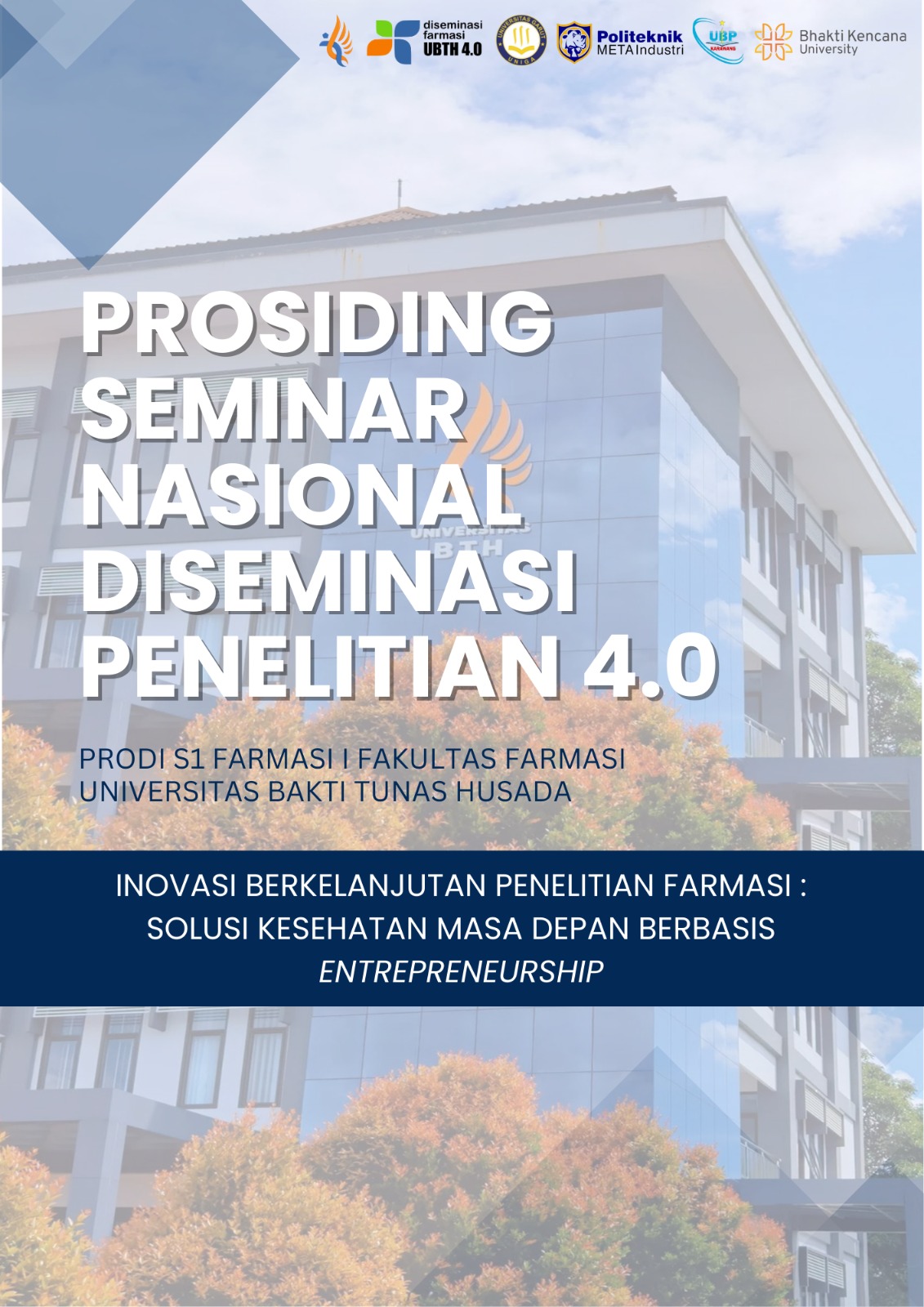Formulasi Sediaan Liptint Dari Ekstrak Kulit Manggis (Garcinia mangostana L.) Sebagai Pewarna Alami Dikombinasikan Dengan Lesitin
Keywords:
liptint, mangosteen peel extract, antioxidantAbstract
Liptint is a cosmetic product used to apply lip color. Liptint is often liquid and has a natural color.
Mangosteen peel contains mangosteen, flavonoids and tannins. It has antioxidant activity that has the
ability to prevent lip skin from becoming black. The aim of this study was to determine the concentration
of mangosteen peel extract liptint formula (Garcinia mangostana L.) that was most liked by respondents,
to determine the results of the evaluation of liptint preparations from mangosteen peel (Garcinia
mangostana L.) and to determine the level of lip moisture in the formula of mangosteen peel extract
liptint preparation (Garcinia mangostana L.). Using maceration extraction method. The concentration of
liptint preparation extract in each formula F1 (2%) b/v, F2 (4%) b/v and F3 (6%) b/v. The mangosteen
peel extract liptint preparation has met the evaluation requirements of organoleptic test, homogeneity
test, pH test, irritation test, spreadability test, stability test, viscosity and rheology test, moisture test and
hedonic test. The data obtained was analyzed by Friedman test with the result of <0.05 which means
there is a significant difference between each treatment. In the moisture effectiveness test, it was
analyzed by paired sample T test with the result <0.05 that there was a significant difference in moisture
before and after using the liptint preparation.
References
Abadi, H., Parhan, P., Winata, H. S., & Nidawah, N. (2022). Formulasi Sediaan Lip Cream Dari Ekstrak Etanol Daun Bayam Merah (Amaranthus tricolor L.). Majalah Farmasetika, 7(3), 106. https://doi.org/10.24198/mfarmasetika.v7i3.38429
Ali, S. M., & Yosipovitch, G. (2013). Skin pH: From basic science to basic skin care. Acta Dermato-Venereologica, 93(3), 261–
267. https://doi.org/10.2340/00015555-1531
Anisa, H., Sukmawardani, Y., & Windayani, N. (2019). A simple formulation of lip balm using carrot extract as a natural coloring
agent. Journal of Physics: Conference Series, 1402(5), 115–121. https://doi.org/10.1088/1742-6596/1402/5/055070
Aulia, S. A., & Widowati, T. (2018). Pembuatan Liptint dari Ekstrak Buah Bit. Bbhe, 7(1), 18–22.
Ayu Nara. (2019). Formulasi Lip Cream Ekstrak Etanol Kulit Buah Terong Belanda (Solanum betaceum) Sebagai Pewarna
Alami. Debiyanti, Y. (2022). Formulasi dan uji sifat fisik sediaan lip tint menggunakan ekstrak buah bit (Beta vulgaris L.) sebagapewarna alami. In Skripsi Universitas dr.Soebandi Jember. http://repository.stikesdrsoebandi.ac.id/477/
Depkes RI. (2000). Parameter Standar Umum Ekstrak Tumbuhan Obat. Dwicahyani, U., Isrul, M., & Noviyanti, W. O. N.
(2019). Formulasi Sediaan Lipstik Ekstrak Kulit Buah Ruruhi (Syzygium policephalum Merr) Sebagai Pewarna. Jurnal Mandala Pharmacon Indonesia, 5(02), 91–103. https://doi.org/10.35311/jmpi.v5i02.48
Erwiyani, A. R., Destiani, D., & Kabelen, S. A. (2018). Pengaruh Lama Penyimpanan Terhadap Sediaan Fisik Krim Daun Alpukat (Persea Americana Mill) dan daun sirih hijau (Piper betle Linn). Indonesian Journal of Pharmacy andNatural Product, 1(1), 23–29.
https://doi.org/10.35473/ijpnp.v1i1.31
Faradilla, J., Herawati, E., Siti, N., & Ambarwati, S. (2018). FORMULASI DAN EVALUASI SEDIAAN LIPSTIK EKSTRAK KULIT BUAH NAGA MERAH ( Hylocereus polyrhizus ). 7, 1–11.
Gustaman, F., Yuliana, A., & Nurahman, R. P. (2023). Formulasi dan Uji Sifat Fisik Lip lint Beras Merah (Oryza nivara s.d.sharma & shastry) dengan Kombinasi Buah Naga (Hylocereus costaricensis).Prosiding Seminar Nasional Diseminasi Penelitian, 3(September), 250–260.
Hardani, Pertiwi, A. D., Hartanto, F. A. D., Ghozaly, M. R., Rahim, A., Idawati, S., Dewi, I. K., Monika, N. D., & Ulya, T. (2021). Buku Ajar Farmasi Fisika. Samudra Biru, 214. ICH. (2003). International Conference on Harmonization (ICH). Guidance for industry: Q1A(R2) Stability Testing of New drug Substances and Products. ICH Harmonised Tripartite Guideline, 4(February), 24.
Imani, C. F. (2022). ( Aloe vera L .) MOISTURE TEST OF ALOE VERA ( Aloe vera L .) LEAF EXTRACT LIP BALM Cahaya Firdausi Imani , 1 Fenita Shoviantari *. Jurnal Pharma Bhakta, 2(44), 44–51.
Kadu, M., Vishwasrao, S., & Singh, S. (2015). ISSN 2277 – 7172 Review Article Review on Natural Lip Balm. International Journal
of Research in Cosmetic Science, 5(1), 1–7.
Nabila Nur Latifa, Lanny Mulqie, & Siti Hazar. (2022). Penetapan Kadar Sari Larut Air dan Kadar Sari Larut Etanol Simplisia
Buah Tin (Ficus carica L.). Bandung Conference Series: Pharmacy, 2(2). https://doi.org/10.29313/bcsp.v2i2.4575
Rahmawati, K. P., Abdul Muin, Diah Miftahul Aini, Baiq Desy Ratnasri, & Faelga Sara Rosiana. (2022). Pemanfaatan Kulit Buah
Manggis Sebagai Bahan Campuran dalam Panganan Manyarakat Sebagai Upaya Penanganan Limbah Kulit Manggis. 1(2), 111–118.
https://doi.org/10.55927/jpmf.v1i2.538
Septiani, S., Wathoni, N., & Mita, S. R. mita. (2011). Formulasi Sediaan Masker gel Antioksidan Dari Ekstrak Etanol Biji Belinjo. Fakultas Farmasi Universitas Padjajaran, 2–4.
Sintia, U., Andayani, R., & Lucida, H. (n.d.). Journal of Pharmaceutical and Sciences |Volume 6|No. Sogandi, S., Fitrianingrum, M., & Thursina, A. (2020). Identifikasi Senyawa Bioaktif Identifikasi Senyawa Bioaktif dan Aktivitas Antibakteri Ekstrak Daun Mengkudu
(Morinda citrifolia L.) sebagai Inhibitor Propionibacterium acne. Buletin Penelitian Kesehatan, 48(1), 73–82.
https://doi.org/10.22435/bpk.v48i1.2338
Syam, N. R., Lestari, U., & Muhaimin. (2021). Formulasi dan Uji Sifat Fisik Masker Gel Peel Off dari Minyak Sawit Murni Dengan
Basis Carbomer 940. Indonesian Journal of Pharma Science, 1(1), 28–41. Theodoridis, T., & Kraemer, J. (n.d.). Ekstraksi
Zat Warna Alami Dari Kulit Manggis Serta Uji Stabilitasnya. 1–8.
Tungadi, R., Thomas, N. A., Paneo, M. A., Latif, M. S., & Voenna, C. D. (2024). Formulasi Dan Evaluasi Sediaan Perona Pipi Dalam
Bentuk Compact Powder Menggunakan Zat Pewarna Alami Ekstrak Kulit Buah Manggis ( Garcinia Mangostana L .). Indonesian Journal of Pharmaceutical Education, 4(1), 10–17. https://doi.org/10.37311/ijpe.v4i1.18039

